Bastard Sword: Its History and Hilt Forms
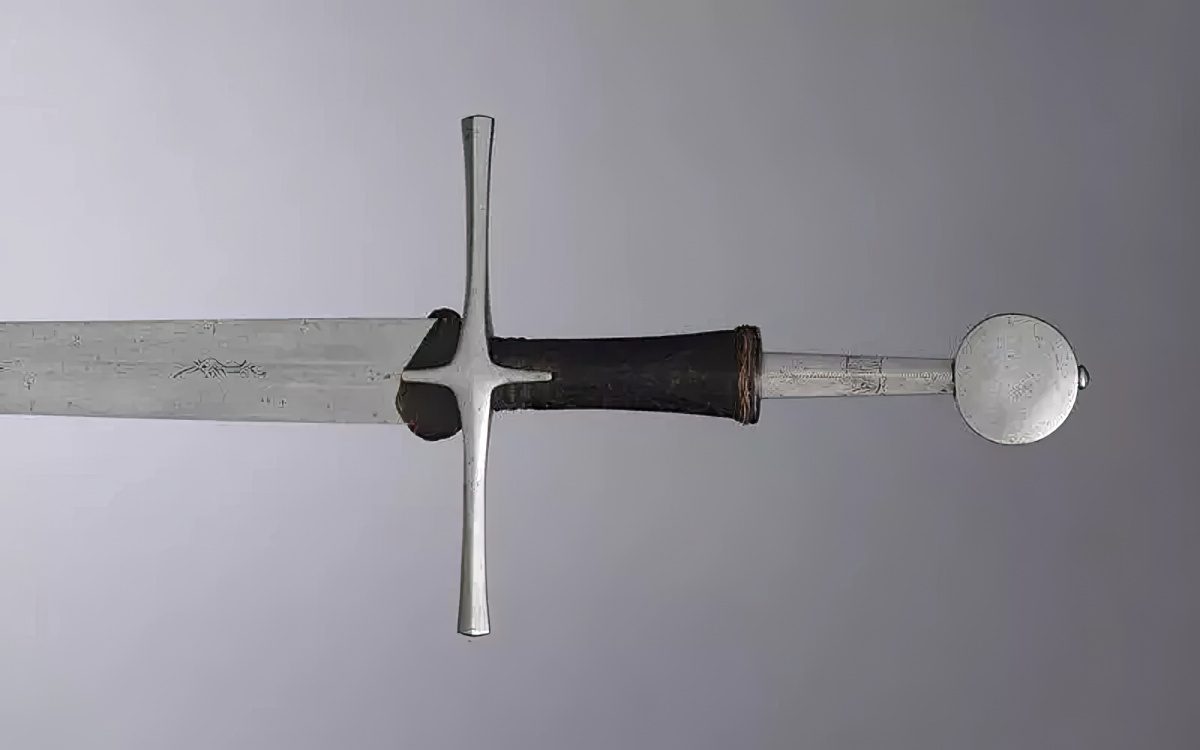
What’s in this article?
The bastard sword, also known as a hand-and-a-half sword, was primarily used with one hand but featured a longer grip that allowed the use of both hands. Neither a one-handed nor two-handed sword, the bastard sword was not a member of either family, hence its name. Often used as an alternative name for a longsword, it is a specific type of longsword used in the 15th and 16th centuries.
Let’s explore the history and unique characteristics of the bastard sword and how it compares to the longsword we know today.
Characteristics of Bastard Swords
The bastard sword is characterized by its hand-and-a-half-grip—often shaped like a bottle or appearing to have a waist—it also features a tapering, sharply pointed blade. Earlier examples had plain crossguards, but later ones featured a more complex hilt.
Here are the unique characteristics of bastard swords:
Metal and Construction
In the 16th century, several sword blades were mass-produced, though they were not always very high in carbon content. Some surviving examples of hand-and-a-half swords have blades made from a single piece of steel, hardened by quenching. However, the tempering techniques of the time were not yet completely mastered.
Modern reproductions of bastard swords widely vary in quality depending on their use. In Historical European Martial Arts (HEMA), stage combat, and historical reenactments, swords often feature high carbon steel blades with blunted edges. Decorative swords often have stainless steel blades while those used in LARP are foam swords.
Blade Appearance
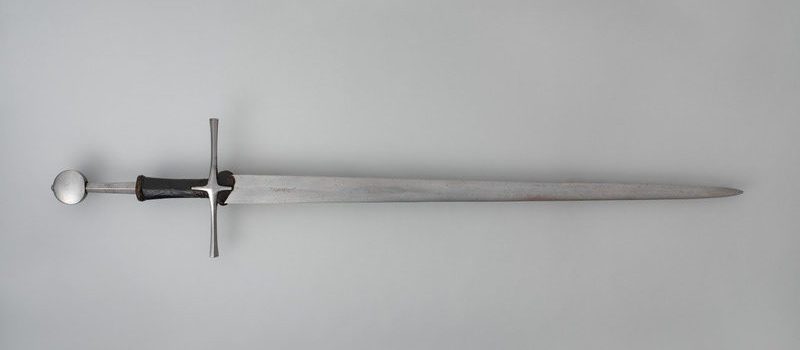
A bastard sword had a straight, double-edged blade. Some were designed for more cutting, while others were better suited for thrusting. Unlike earlier longswords with wider, parallel-edged blades with rounded tips, bastard swords generally had narrower, tapered blades with acutely pointed tips.
Most bastard swords had a diamond cross-section with very narrow points for thrusting. Others had hexagonal cross-sections that cut poorly toward the tip yet excellent for cutting near the hilt. Many bastard swords also featured a ricasso, an unsharpened portion of the blade above the guard. The ricasso allowed the finger to extend around the crossguard for a better grip and greater point control.
Size and Length
Bastard swords vary widely in size, though some fencing masters describe them as short longswords—likely because they are typically short compared to other longswords. Many surviving examples of bastard swords have an average blade length of 35 inches (88.9 centimeters) and a grip length of about 7 inches (17.78 centimeters). Still, others may have shorter or longer blades.
Weight
While a compound hilt design might have added to a sword’s weight, medieval swords in general were well-made and agile fighting weapons. Some bastard swords weighed less than 2 pounds, though others with more complex guards may be slightly heavier, around 3 to 3 1/2 pounds (1.3 to 1.6 kg). Still, bastard swords are lightweight enough to use with one hand and move very quickly.
Sword Mounting
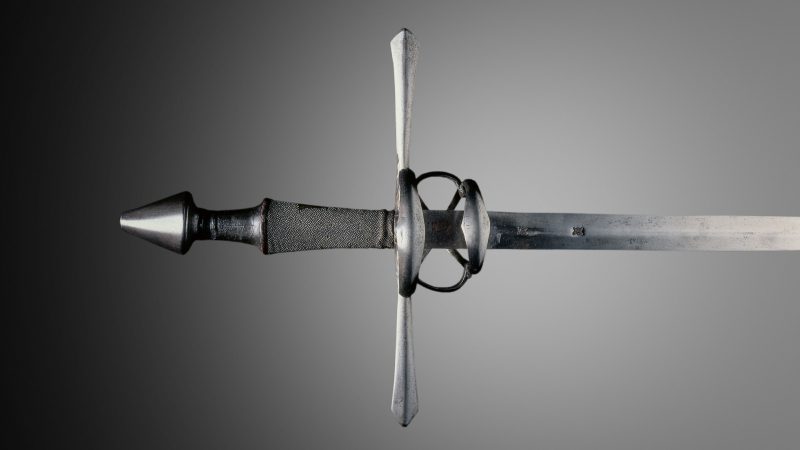
Bastard swords feature specially shaped grips for one or two hands. They initially had a plain crossguard but later acquired a more complex hilt.
Grip
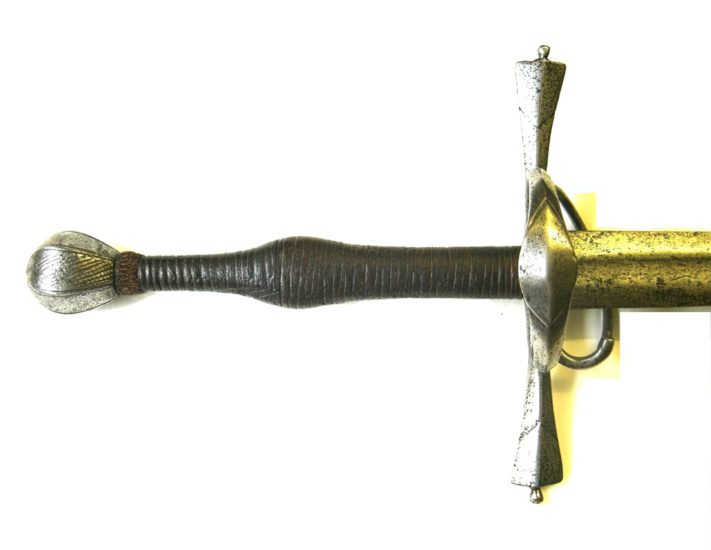
Most recognizable for its waist and bottle shaped grip, the hand-and-a-half handle features a slightly wider middle and tapers towards the pommel to allow a secure hold and better control of the weapon. Some bastard sword grips were made of sharkskin, fitted around a wooden core.
Crossguard
Some bastard swords featured a compound hilt—consisting of finger-rings and side-rings. Finger rings are small loops extending toward the blade from the crossguard. These mainly protect the index finger when wrapped over the guard. Also, the side rings protect the hand and fingers when not wearing heavy gloves or gauntlets.
Scabbard

Medieval bastard swords often had wooden scabbards wrapped in leather. A scabbard typically had a metal chape that kept the sword’s tip from poking through. A warrior usually wore the sword at the waist, vertically hanging from a belt on the left hip.
Types of Bastard Sword Hilts
There are several types of bastard hilt forms, many of which originated in Germany and Switzerland. They generally belong to four main groups, though there are many more sub-types.
Group 1
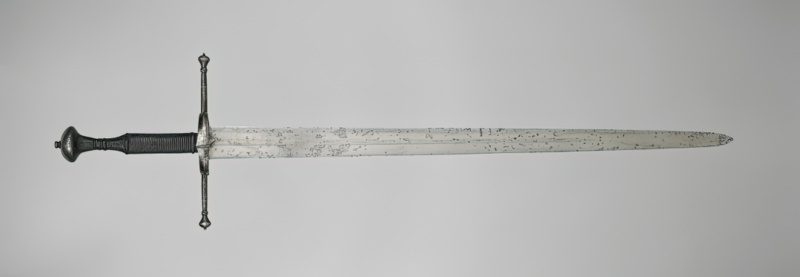
These hilts usually feature straight or sometimes curved quillons (crossguard arms). They also have single side rings on the inside and outside of the hilt.
Group 2
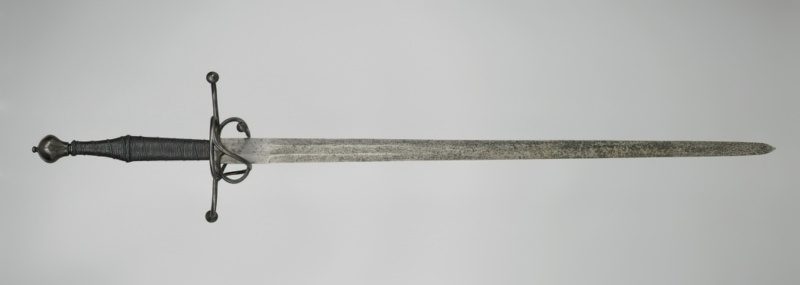
These hilts often have curved or rarely straight quillons. Their guards consist of a ring guard, one or two arms, and a loop back guard.
Group 3
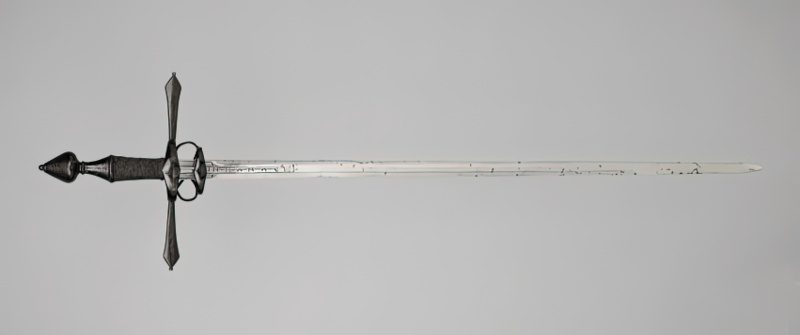
These hilts typically feature quillons, arms, and double rings.
Group 4

These hilts included knuckle guards and additional loop guards of various designs, creating a sort of half-basket guard for the back of the hand.
Bastard Swords vs. Longswords
Bastard swords seem to have referred primarily to the later longswords with tapering blades and special half-grips. The earlier types of longswords were known as grete war swords or epee de guerre, notable for their larger size and blade form.
| Type | Earlier Longsword (War Sword) | Bastard Sword |
| Period | In the 13th and 14th centuries | In the 15th and 16th centuries |
| Oakeshott Types | Types XIIa, XIIIa, and others | Types XVa, XVIa, XVII and XVIIIa |
| Blade Form | Parallel-edged with rounder point | Tapered blade with sharply pointed form |
| Cross-section | Lenticular cross-section | Diamond or hexagonal cross-section |
| Blade Advantage | Their heavy blades were efficient for cutting. | Their tapered blades were ideal for thrusting and moving quickly. |
| Blade Disadvantage | They tend to move a bit slower from technique to technique. | Cutting capability is sacrificed and quite sensitive to bad cutting techniques. |
| Type of Armor | Used against mail | Used for armored combat |
| Technique | Ideal for cutting with the tip and further down the blade. | Ideal for half-swording and close-range thrusting at close distances. |
Bastard Swords vs. Great Swords

Today, the term great sword refers to extremely large swords that require the use of two hands. Examples include the German zweihander, Italian spadone, Iberian montante, Scottish claymore, and others.
Generally, longswords served as a sidearm for knights during the late medieval and early Renaissance. On the other hand, some great swords especially the zweihander, served as a breaching weapon on the battlefield against pikemen.
In HEMA, bastard swords and larger longswords are able to perform the longsword techniques. However, the great swords would not share the same technique set. Also, the zweihander featured a unique blade form, a straight or flammard blade with parrying hooks.
Bastard Swords vs. Arming Swords
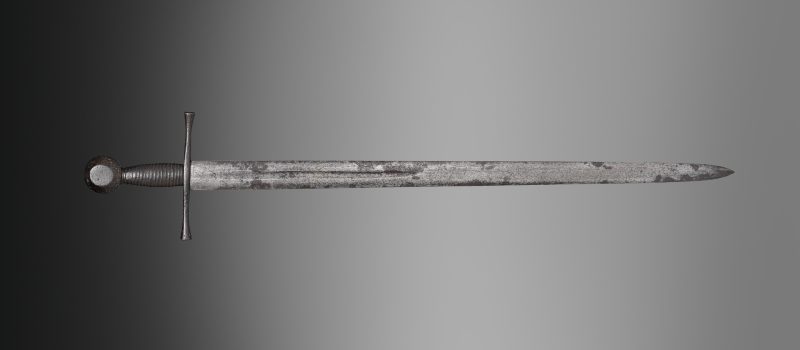
The arming sword, also called the knightly sword, was a single-handed sword typically used with a shield. It developed from the Viking swords and was widely used throughout Europe. It was the typical crusader or Templar sword suited for slashing blows against mail armor.
While the arming sword is a single-handed sword, a bastard sword falls between the one-handed and two-handed swords. Many bastard swords had the same blade length as a typical arming sword.
The bastard swords functioned similarly to the arming sword when wielded in one hand, though the balance would be slightly different. The long hand-and-a-half grip allowed two-handed use to deliver heavier blows against armored opponents.
History of Bastard Swords
The term bastard sword (épée bâtarde in French) was first used in the 15th century. However, it remains uncertain whether it really applied to the earlier larger longswords known as the grete war swords or epee de guerre. Also, the term hand-and-a-half is not historical and was coined by modern collectors.
- The bastard sword was among the tournament weapons.
Throughout the Middle Ages, the medieval knights showed off their martial skills in jousting tournaments. Apart from swords, they also used poleaxes, maces, and lances. The jousting lance was an adapted version of the battlefield weapon, usually with blunted tips and shafts designed to break upon impact. In the 1500s, bastard swords remained to be used by knights and were particularly popular in Italy and Germany.
- Bastard swords widely varied in hilt designs.
Ewart Oakeshott established a typology for categorizing swords by their crossguard style, blade type, and pommel. Within his typology, bastard swords fall into Oakeshott types XVa, XVIa, XVII, and XVIIIa. The Oakeshott type XIX originally consisted of one-handed swords, but later included hand-and-a-half swords.
- The unique bastard sword half-grip was practical and versatile.
A bastard sword handle generally tapers toward a shorter, thinner half-grip. Its waisted shape allowed better control and was efficient for various techniques. In pommeling, the pommel is partly held in the palm of the other hand for more powerful thrusts against heavy armor.
- A compound hilt on bastard swords allowed fingering the ricasso.
The technique of fingering the ricasso helped control the point for stabbing attacks, but it also exposed the finger. In the 1460s, the combination of finger-rings and side-rings appeared on bastard swords. These compound hilts were developed to protect the fingers when warriors were fighting without heavy gauntlets.
- The bastard-style compound hilt also equipped other types of swords.
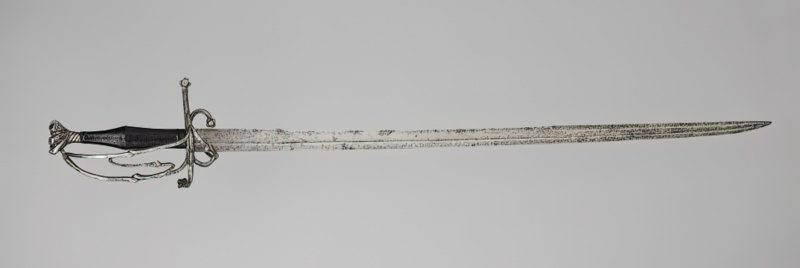
In Switzerland, the Swiss saber had a bastard-type hilt and almost replaced the long straight bastard sword by the early 16th century. The bastard-style compound guard was also found on Renaissance two-handed swords, cut-and-thrust swords, and later rapiers. It also developed into the early typical forms of broadsword hilts of the 17th and 18th centuries.
The Bastard Sword in HEMA
In HEMA, the bastard sword or hand-and-a-half sword, estoc, and various other terms refer to the swords we call today as longswords. The longsword refers to swords lightweight enough to use in one hand yet feature a long grip to use both hands. Generally, these swords have blade lengths of around 33 to 40 inches and grip lengths of 7 to 10 inches.
There might be several types of longswords, but they share the same technique set. Their difference in size, hilt form, grip, shape, and cross-section will not make much difference to the techniques that can be done with them. Bastard swords generally excel at half-swording, close-range thrusting, and armored combat.
Conclusion
The bastard sword was the typical knight’s sword of the 15th and 16th centuries. It featured a specially shaped grip for one or two hands, though its hilt forms varied throughout history. As a variety of longswords, the bastard sword, also called the hand-and-a-half sword, remains significant among HEMA practitioners, military historians, and collectors.




